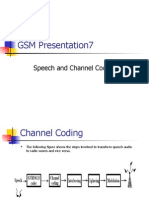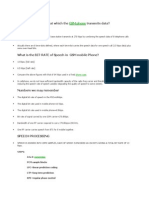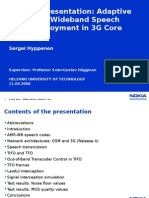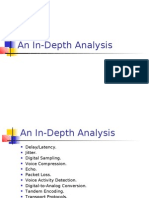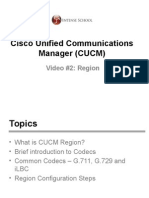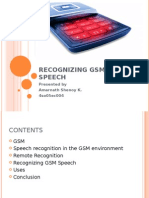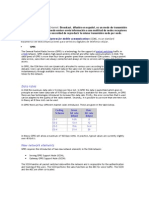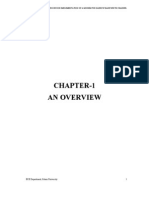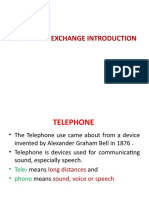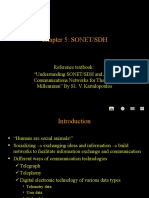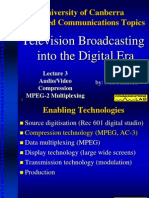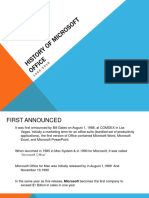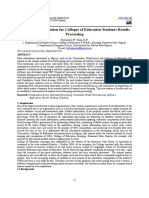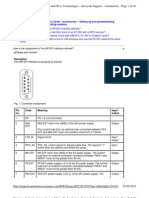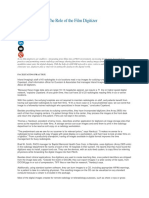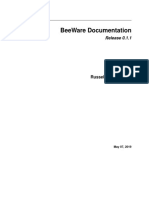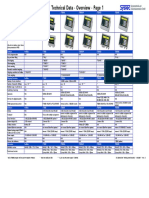0 ratings0% found this document useful (0 votes)
68 viewsGSM Network and Services: Voice Coding
GSM Network and Services: Voice Coding
Uploaded by
moontida451. The document discusses how voice is encoded in GSM networks, from sampling the voice into digital signals, applying various coding techniques like source coding, channel coding, and modulation before transmission over radio waves.
2. It explains why digital encoding is used rather than analog - to allow for compression, error detection, adaptation to radio conditions, and half-duplex communication. The GSM voice codec samples voice at 8 kHz and encodes it using linear predictive coding and regular pulse excitation coding into 260 bits per 20 ms frame.
3. Discontinuous transmission is described, where silence periods are detected and only identification codes are sent to maintain the connection, saving bandwidth. Comfort noise is generated at receivers to avoid silent
Copyright:
© All Rights Reserved
Available Formats
Download as PDF, TXT or read online from Scribd
GSM Network and Services: Voice Coding
GSM Network and Services: Voice Coding
Uploaded by
moontida450 ratings0% found this document useful (0 votes)
68 views21 pages1. The document discusses how voice is encoded in GSM networks, from sampling the voice into digital signals, applying various coding techniques like source coding, channel coding, and modulation before transmission over radio waves.
2. It explains why digital encoding is used rather than analog - to allow for compression, error detection, adaptation to radio conditions, and half-duplex communication. The GSM voice codec samples voice at 8 kHz and encodes it using linear predictive coding and regular pulse excitation coding into 260 bits per 20 ms frame.
3. Discontinuous transmission is described, where silence periods are detected and only identification codes are sent to maintain the connection, saving bandwidth. Comfort noise is generated at receivers to avoid silent
Original Title
Voice
Copyright
© © All Rights Reserved
Available Formats
PDF, TXT or read online from Scribd
Share this document
Did you find this document useful?
Is this content inappropriate?
1. The document discusses how voice is encoded in GSM networks, from sampling the voice into digital signals, applying various coding techniques like source coding, channel coding, and modulation before transmission over radio waves.
2. It explains why digital encoding is used rather than analog - to allow for compression, error detection, adaptation to radio conditions, and half-duplex communication. The GSM voice codec samples voice at 8 kHz and encodes it using linear predictive coding and regular pulse excitation coding into 260 bits per 20 ms frame.
3. Discontinuous transmission is described, where silence periods are detected and only identification codes are sent to maintain the connection, saving bandwidth. Comfort noise is generated at receivers to avoid silent
Copyright:
© All Rights Reserved
Available Formats
Download as PDF, TXT or read online from Scribd
Download as pdf or txt
0 ratings0% found this document useful (0 votes)
68 views21 pagesGSM Network and Services: Voice Coding
GSM Network and Services: Voice Coding
Uploaded by
moontida451. The document discusses how voice is encoded in GSM networks, from sampling the voice into digital signals, applying various coding techniques like source coding, channel coding, and modulation before transmission over radio waves.
2. It explains why digital encoding is used rather than analog - to allow for compression, error detection, adaptation to radio conditions, and half-duplex communication. The GSM voice codec samples voice at 8 kHz and encodes it using linear predictive coding and regular pulse excitation coding into 260 bits per 20 ms frame.
3. Discontinuous transmission is described, where silence periods are detected and only identification codes are sent to maintain the connection, saving bandwidth. Comfort noise is generated at receivers to avoid silent
Copyright:
© All Rights Reserved
Available Formats
Download as PDF, TXT or read online from Scribd
Download as pdf or txt
You are on page 1of 21
1
GSM Network and Services 2G1723 Johan Montelius
GSM Network and Services
Voice coding
2
GSM Network and Services 2G1723 Johan Montelius
From voice to radio waves
voice/source coding
channel coding
block coding
convolutional coding
interleaving
encryption
modulation
diff encoding
symbol coding
carrier modulation
burst building
3
GSM Network and Services 2G1723 Johan Montelius
Why digital?
link quality
speech
quality
analog
bit rate
compressed
digital
4
GSM Network and Services 2G1723 Johan Montelius
Analog vs Digital
If radio conditions are very good, an analog
connection could do the job and in many cases a
better job.
Digital coding allows:
compression
error detection and error correction
half duplex implementation
adaption to radio conditions
Digital drawback: processing, delay, voice only
codecs.
5
GSM Network and Services 2G1723 Johan Montelius
GSM voice codec
Sampled at 8 kHz, 13 bits per sample. Compare
this to regular A-law coding that samples at 8kHz
using 8 bits per sample.
Divides the sampled voice into 20 ms blocks for
the codec to work on. Each block is coded in 260
bits resulting in 13 kb/s.
The GSM codec is based on modeling of human
speech organs. Tuned for males!
Voice activation to allow discontinuous
transmission.
6
GSM Network and Services 2G1723 Johan Montelius
Remember
The 260 bits from the voice codec are encoded
using 456 bits that are interleaved into eight bursts
(half of each burst).
A 26-multiframe last for 120 ms and holds 24 TCH
burst, 1 SACCH burst and one idle frame.
24/4 = 6 voice samples every 26-multiframe.
26-multiframe takes 120 ms that is equal to 6 voice
samples of 20 ms.
One frame takes 120/26 = 4.6 ms.
7
GSM Network and Services 2G1723 Johan Montelius
GSM discontinuous transmission
sample
voice coder
voice activation det.
VAD
voice
DTX coder
frame
SP
comfort noise synth
SID
Silence Descriptor
8
GSM Network and Services 2G1723 Johan Montelius
DTX coder
The coder will detect if the sample is voice or
silence. When detected the Voice activity
detection will set a VAD bit to 1.
The voice coder will output a voice frame of 260
bits or a SID frame of 35 bits.
Depending on the VAD bit the DTX will output
voice frames or SID frames.
The DTX will pass the voice frames or in band
encoded SID frames to the channel coder.
9
GSM Network and Services 2G1723 Johan Montelius
DTX encoder
The channel coder will, based on the SP flag,
control when data is actually sent over the air:
any frame that contains speech information
the first frame after a speech frame since it
holds a SID frame
frames to keep the radio measurement
active
10
GSM Network and Services 2G1723 Johan Montelius
Comfort noise
If there is no noise in the background when
you speak you will think that the connection
is lost. This is extremely annoying
Since phone conversations are almost
always half duplex it is wasteful to keep a
full duplex connection open.
Why? Wasting what?
11
GSM Network and Services 2G1723 Johan Montelius
DTX decoder
voice
voice coder
bad frame
BFI
sample
DTX
voice
comfort noise synth
SID
12
GSM Network and Services 2G1723 Johan Montelius
DTX decoder
Correct voice frames are passed directly to the
voice decoder.
Correct SID frames are passed to the comfort
noise synthesizer.
If the Bad Frame Indicator (BFI) is set then
an incorrect voice frame is replaced by the
previous
an incorrect SID frame is replaced by the last
valid SID frame or last valid speech frame (that
probably contains noise)
13
GSM Network and Services 2G1723 Johan Montelius
Waveform vs Vocoder
Waveform codecs encode audio with no
knowledge of the signal.
Pulse Code Modulation (PCM) is one example that is
used in fixed line telephony.
Vocoder, or source coders, try to represent the
audio generator, in this case the vocal tract, and
represent a sample as a the parameters that define
the generator.
Vocoders can encode speech at a very low bit rate.
Even if the result does not sound like the original audio
signal.
14
GSM Network and Services 2G1723 Johan Montelius
Voice codec
0 1 2 4 8 16 32 64
0
1
2
3
4
5
6
7
8
10
!odecs
waveform
vocoder
hybrid
bit rate kb/s
quality
15
GSM Network and Services 2G1723 Johan Montelius
Hybrid coder
In a hybrid coder a vocoder is used to
encode the voice signal.
The decoded sample of the result is then
compared to the original sample.
The difference between the original and the
decoded result is encoded using a
waveform coder.
The result is a high quality low bit rate
codec.
16
GSM Network and Services 2G1723 Johan Montelius
GSM codec
short-term
LPC
short-term
filter 2080 bits
104kb/s
LTP
analysis
long-term
filter
36 bits (1.8 kb/s)
RPE
encoding
36 bits (1.8 kb/s)
188 bits
9.4 kb/s
Linear Predictive Coder
Long Term Prediction
Regular Pulse Excitation
RPE-LTP LPC
17
GSM Network and Services 2G1723 Johan Montelius
GSM codec
The resulting 260 bits are divided into:
Class 1A: 50 most significant bits
Class 1B: 132 significant bits
Class 2: 78 less significant bits
Classing is done by subjective evaluation of the
perceived speech quality (Mean Opinion Score,
MOS).
18
GSM Network and Services 2G1723 Johan Montelius
Channel coding
IA 50 b IB 132 b II 78 b
25 25 3
25 66 3 66 25 4
378 b after convolutional coding II 78 b
19
GSM Network and Services 2G1723 Johan Montelius
Other codecs
Half rate (HR): 6.5 kb/s used to increase capacity
since it only needs a half rate TCH. Speech
quality is considerably less.
Enhanced Full Rate (EFR): 12.2 kb/s but further
protected by CRC in a resulting 13 kb/s codec.
Better speech quality.
Adaptive Multi Rate (AMR): the codec adapts to
the radio conditions; high BER will use a low rate
codec that is better protected .
20
GSM Network and Services 2G1723 Johan Montelius
AMR
k"#s 12$2 10$2 6$7 4$75
%lock 244 204 134 5
!lass 1& 81 65 55 3
'ate (1#2) (1#3) (1#4) (1#5)
'aw 508 642 576 535
*uncturin+ 60 14 128 87
'esult 448 448 448 448
,n "and 8 8 8 8
-ra.e 456 456 456 456
21
GSM Network and Services 2G1723 Johan Montelius
BSS side coder
TRAU
BSC
MS
GSM voice
signaling
MSC
Alaw
!S"#
The TRAU needs not only the 13kb/s voice stream but also
BFI information etc. 3 kb/s signaling and error detection is
added resulting in a 16 kb/s stream.
4 streams will share a 64 kb/s ISDN channel
You might also like
- ITIL Intermediate Capability OSASample1 QUESTION BOOKLET v6.1Document11 pagesITIL Intermediate Capability OSASample1 QUESTION BOOKLET v6.1Anonymous zWUrYoc2VNo ratings yet
- NePA WalkThroughDocument8 pagesNePA WalkThroughvphuc1984100% (1)
- GSM Network and Services: Channel Coding - From Source Data To Radio BurstsDocument21 pagesGSM Network and Services: Channel Coding - From Source Data To Radio BurstsTrevorPNo ratings yet
- Speech CodingDocument2 pagesSpeech CodingshabeehNo ratings yet
- Wideband Voice Coding - Opportunities and Implementation ChallengesDocument6 pagesWideband Voice Coding - Opportunities and Implementation ChallengeshoainamcomitNo ratings yet
- GSM Network and Services: Channel Coding - From Source Data To Radio BurstsDocument21 pagesGSM Network and Services: Channel Coding - From Source Data To Radio BurstsHồ ThôngNo ratings yet
- GB - BT1002 - E01 - 0 GSM Radio Interface Technology 33Document30 pagesGB - BT1002 - E01 - 0 GSM Radio Interface Technology 33noumizredhaNo ratings yet
- Unit III AudioDocument22 pagesUnit III AudioArthinathan SaamNo ratings yet
- ATA IP Phone: Compression - DecompressionDocument8 pagesATA IP Phone: Compression - Decompressionabhia16No ratings yet
- ETSI CodecsDocument36 pagesETSI Codecsadam_imamNo ratings yet
- SIP - CodecsDocument2 pagesSIP - CodecsVISHAL KUMARNo ratings yet
- Understanding The GSM CodecDocument12 pagesUnderstanding The GSM Codeckan077bei023No ratings yet
- 9.GSM Speech & Channel CodingDocument29 pages9.GSM Speech & Channel Codingmanthasaikarthik93% (15)
- GSM Data RateDocument3 pagesGSM Data RateVikas NigamNo ratings yet
- Seminar Presentation: Adaptive Multi-Rate Wideband Speech Codec Deployment in 3G Core NetworkDocument16 pagesSeminar Presentation: Adaptive Multi-Rate Wideband Speech Codec Deployment in 3G Core NetworkquanotNo ratings yet
- An In-Depth AnalysisDocument41 pagesAn In-Depth Analysisapi-19663123No ratings yet
- DSA0089894Document12 pagesDSA0089894alaasalaheldein905No ratings yet
- Voice Over IPDocument53 pagesVoice Over IPGil HaleNo ratings yet
- CUCM Video Series RegionDocument9 pagesCUCM Video Series RegionjamalnizamNo ratings yet
- Recognizing GSM Digital Speech: Presented by Amarnath Shenoy K. 4so05ec004Document23 pagesRecognizing GSM Digital Speech: Presented by Amarnath Shenoy K. 4so05ec004amarnathshenoy5852No ratings yet
- Digital Speech ProcessingDocument18 pagesDigital Speech ProcessingMohamedKadryNo ratings yet
- Training Session No.: Digital AudioDocument28 pagesTraining Session No.: Digital AudioMohd AmirNo ratings yet
- GSM Speech CodersDocument7 pagesGSM Speech Coders1DA15EC023 BHARGAVA SNo ratings yet
- What Is MPEGDocument5 pagesWhat Is MPEGARTMehr Eng. GroupNo ratings yet
- Glosario de TCSDocument4 pagesGlosario de TCSMatias WolfNo ratings yet
- ONT10S02 Voice Over IPDocument106 pagesONT10S02 Voice Over IPAakash GoelNo ratings yet
- Sub-Band CodingDocument2 pagesSub-Band Codingsebastian431No ratings yet
- Voice Over IP (VoIP)Document54 pagesVoice Over IP (VoIP)Peter R. Egli100% (1)
- MAC and HDTVDocument7 pagesMAC and HDTVKaran Singh PanwarNo ratings yet
- Audio CompressionDocument81 pagesAudio CompressionRohan BorgalliNo ratings yet
- Chapter 5: SONET/SDHDocument100 pagesChapter 5: SONET/SDHrahul_mhatre_26No ratings yet
- MMA Theory Assignment: 1. Critique Time and Frequency Domain Feature Pipeline With Diagram? SolutionDocument17 pagesMMA Theory Assignment: 1. Critique Time and Frequency Domain Feature Pipeline With Diagram? SolutionraghudatheshNo ratings yet
- DSP Processor Implementation of A Modem For Narrow Bandwidth ChannelDocument94 pagesDSP Processor Implementation of A Modem For Narrow Bandwidth Channelsashi_s2No ratings yet
- UntitledDocument1 pageUntitledVanitha KaremollaNo ratings yet
- Properties of Radio Path: 1 © Nokia Bss - Ppt/EgDocument22 pagesProperties of Radio Path: 1 © Nokia Bss - Ppt/EgAinul Haque Siddique QadriNo ratings yet
- Telephone Exchange IntroductionDocument102 pagesTelephone Exchange IntroductionPankaj kumarNo ratings yet
- 1 5 Analog To Digital Voice EncodingDocument10 pages1 5 Analog To Digital Voice EncodingDương Thế CườngNo ratings yet
- Synchronous Modems: Synchronous Data Phase Modulation Integrated Phase and AmplitudeDocument6 pagesSynchronous Modems: Synchronous Data Phase Modulation Integrated Phase and Amplitudea2kashNo ratings yet
- Synchronous ModemsDocument6 pagesSynchronous ModemsMr Asraf AllyNo ratings yet
- 2015 Chapter 11 MMS ITDocument11 pages2015 Chapter 11 MMS ITMercy DegaNo ratings yet
- Payload 4 02Document232 pagesPayload 4 02rahul_mhatre_26No ratings yet
- Multi-Standard Receiver DesignDocument54 pagesMulti-Standard Receiver DesignWalid_Sassi_TunNo ratings yet
- The Wonderful World of Voice CodecsDocument5 pagesThe Wonderful World of Voice Codecsbajim76082No ratings yet
- Analogue Radio VsDocument25 pagesAnalogue Radio Vsquantum22No ratings yet
- Cisco VoIP - RonakDocument26 pagesCisco VoIP - RonakRonak S AswaneyNo ratings yet
- Onec™-Amr Gprs Baseband: One-Chip Baseband With Enhanced Voice Quality For 2.5G Gsm/Gprs HandsetsDocument2 pagesOnec™-Amr Gprs Baseband: One-Chip Baseband With Enhanced Voice Quality For 2.5G Gsm/Gprs Handsetsomkamatchi100% (1)
- DMR TrunkingDocument10 pagesDMR TrunkingmarkxusNo ratings yet
- GSM Speech Coding and Speaker Recognition PDFDocument4 pagesGSM Speech Coding and Speaker Recognition PDFyusufapwNo ratings yet
- Application NoteDocument11 pagesApplication NoteanirudhaNo ratings yet
- Audio Codes Product CatalogDocument37 pagesAudio Codes Product CatalogKersic1No ratings yet
- Planning Networks For VOIP: An IntroductionDocument10 pagesPlanning Networks For VOIP: An IntroductionprincesasiNo ratings yet
- Telecommunications Switching Systems 11Document9 pagesTelecommunications Switching Systems 11Ramcharan BuddiNo ratings yet
- At Any Time Wonder The History of Protected Calls or How To Encrypt Voice Calls.20140316.042015Document2 pagesAt Any Time Wonder The History of Protected Calls or How To Encrypt Voice Calls.20140316.042015teller5crossNo ratings yet
- Lca 2012 Codec2Document32 pagesLca 2012 Codec2aliNo ratings yet
- Basic Architecture of A Digital Catv HeadendDocument6 pagesBasic Architecture of A Digital Catv Headendboyetcinco100% (1)
- Dolby Ac3Document43 pagesDolby Ac3Surekha SundarrNo ratings yet
- MScDCOM-Lec08v2 With AnnotationsDocument7 pagesMScDCOM-Lec08v2 With AnnotationsJai GaizinNo ratings yet
- How CDMA WorksDocument97 pagesHow CDMA Workswaqasahmed1988100% (1)
- Beyond VoIP Protocols: Understanding Voice Technology and Networking Techniques for IP TelephonyFrom EverandBeyond VoIP Protocols: Understanding Voice Technology and Networking Techniques for IP TelephonyNo ratings yet
- BICSI RCDD Registered Communications Distribution Designer Exam Prep And Dumps RCDD-001 Exam Guidebook Updated QuestionsFrom EverandBICSI RCDD Registered Communications Distribution Designer Exam Prep And Dumps RCDD-001 Exam Guidebook Updated QuestionsNo ratings yet
- History of Microsoft OfficeDocument7 pagesHistory of Microsoft OfficeErma GenerosoNo ratings yet
- Epo 510 RG Log Files 0-00 En-UsDocument10 pagesEpo 510 RG Log Files 0-00 En-UsabbuasherNo ratings yet
- CCNA 2 Final Exam Answers V3.1Document25 pagesCCNA 2 Final Exam Answers V3.1Antonio DrexNo ratings yet
- BSS OAM BSC Architecture v4Document109 pagesBSS OAM BSC Architecture v4dattarajrfNo ratings yet
- A Software Application For Colleges of Education Students Results ProcessingDocument13 pagesA Software Application For Colleges of Education Students Results ProcessingUcheNo ratings yet
- Analysis Report - Developing An Employee Expense Management AppDocument10 pagesAnalysis Report - Developing An Employee Expense Management Appapi-268742175No ratings yet
- How To Find 0day VulnerabilityDocument14 pagesHow To Find 0day VulnerabilityAceAnsNo ratings yet
- How Is The Assignment of The MPI DP Interface DefinedDocument10 pagesHow Is The Assignment of The MPI DP Interface Definedwww.otomasyonegitimi.com100% (1)
- Analog To DigitalDocument3 pagesAnalog To Digitalver_at_workNo ratings yet
- Password CrackingDocument6 pagesPassword CrackingRitesh KumarNo ratings yet
- Internet Service Provider (ISP) Central ZoneDocument6 pagesInternet Service Provider (ISP) Central Zoneontohin opekkhaNo ratings yet
- Full Civil Engineering Format-1 PDF LoveDocument1 pageFull Civil Engineering Format-1 PDF Lovedeinkelly7No ratings yet
- Troubleshooting Windows AzureDocument16 pagesTroubleshooting Windows AzureJonathan MendozaNo ratings yet
- RFC 3551Document6 pagesRFC 3551jupivipaNo ratings yet
- BeewareDocument10 pagesBeewareElexir AINo ratings yet
- Lexmark x264dn x363dn x364dn x364dw Service Manual PagesDocument10 pagesLexmark x264dn x363dn x364dn x364dw Service Manual PagesinvisiblemankNo ratings yet
- Readme Borland C++Document7 pagesReadme Borland C++Suflea Claudiu-AlexandruNo ratings yet
- Mercedes ActrosDocument1 pageMercedes Actrossmole7960% (15)
- TDC 3000 Advanced Process Manager Specification and Technical DataDocument28 pagesTDC 3000 Advanced Process Manager Specification and Technical DataJosephus RavaneraNo ratings yet
- Survey On Anomaly Detection of (Iot) - Internet of Things Cyberattacks Using Machine LearningDocument3 pagesSurvey On Anomaly Detection of (Iot) - Internet of Things Cyberattacks Using Machine LearningegamrNo ratings yet
- BMSDP LogDocument2 pagesBMSDP LogRohit SharmaNo ratings yet
- Ictl Form 1 Test 1Document10 pagesIctl Form 1 Test 1Ros ItaNo ratings yet
- Vmware Validated Design 42 SDDC IntroductionDocument66 pagesVmware Validated Design 42 SDDC IntroductiongutinNo ratings yet
- Access 2002 VBA HandbookDocument51 pagesAccess 2002 VBA Handbookalynutzza90No ratings yet
- Iflex Link-Belt InstallDocument25 pagesIflex Link-Belt InstallmliugongNo ratings yet
- Gaming Control Board: Multi Vision ManualDocument14 pagesGaming Control Board: Multi Vision ManualNelson OrjuelaNo ratings yet
- Terminal Overview SystecDocument2 pagesTerminal Overview SystecVentas PesamaticIndustrialNo ratings yet
- 599 Csol 560 - A-Team - Architectural and System Design-1Document9 pages599 Csol 560 - A-Team - Architectural and System Design-1api-425935721No ratings yet












